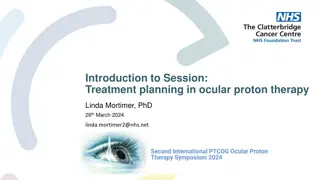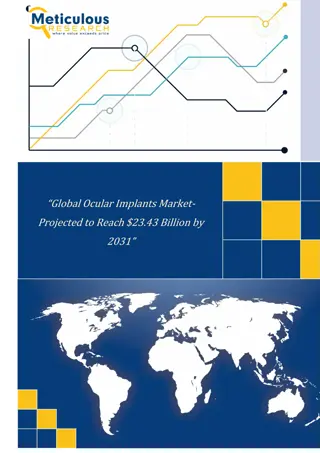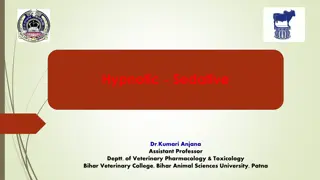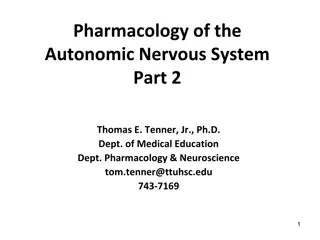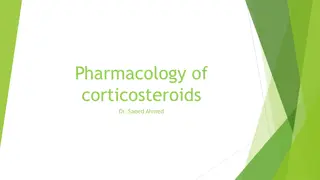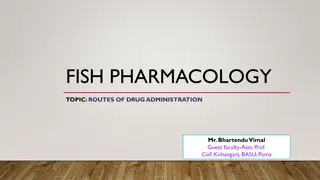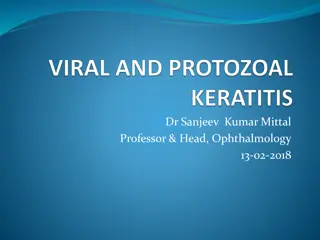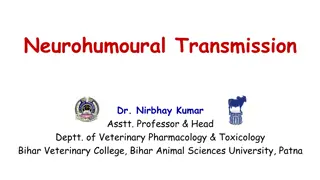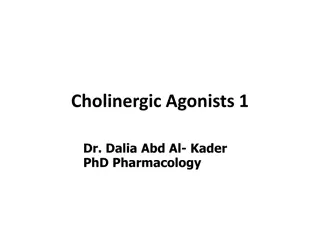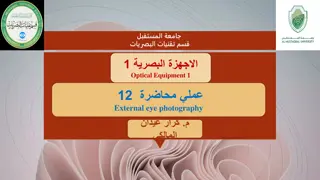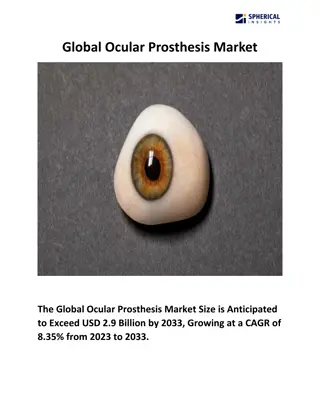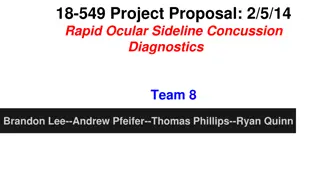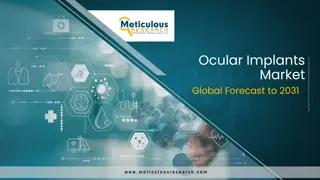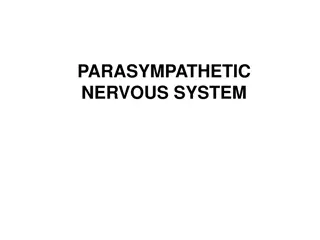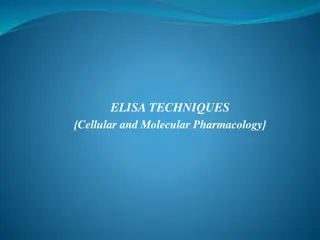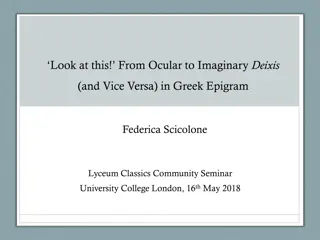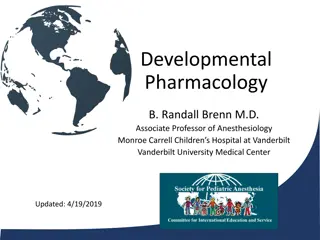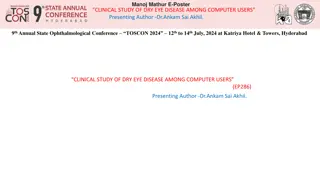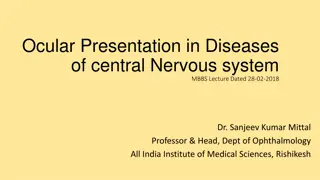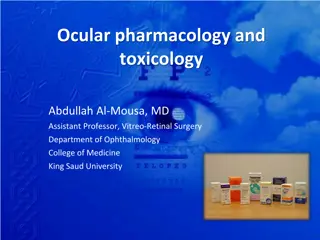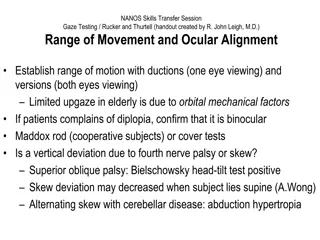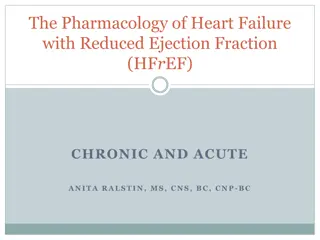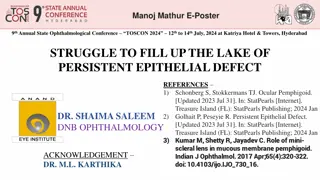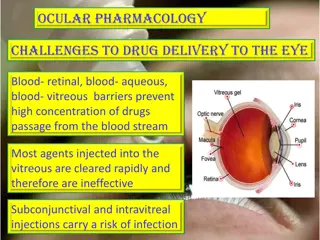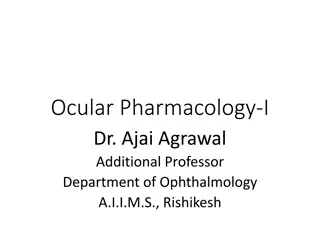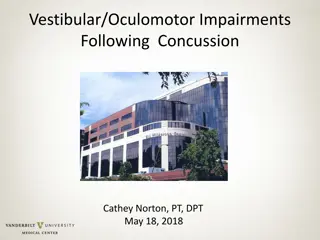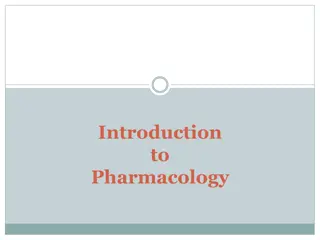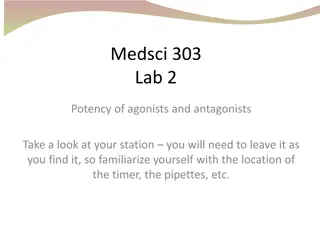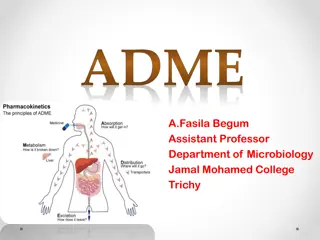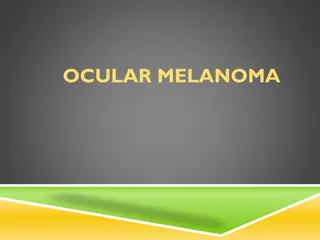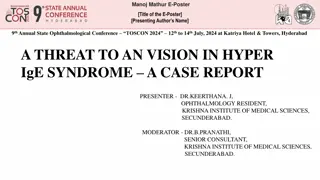Understanding Pharmacokinetics in Clinical Pharmacology
Pharmacokinetics, as explained in a lecture by Oula Mohammed Sami, M.B.Ch.B/MSc in clinical pharmacology, delves into how the body processes drugs, contrasting with pharmacodynamics which focuses on drug actions. Key topics covered include properties influencing treatment outcomes, the significance
6 views • 45 slides
Advances in Ocular Proton Therapy Treatment Planning
Explore the intricate world of ocular proton therapy treatment planning with Dr. Linda Mortimer, PhD. Discover the fundamental elements of an ocular treatment plan, main goals of treatment planning, an overview of dedicated ocular Treatment Planning Systems (TPS), planning workflows, choice of TPS,
1 views • 12 slides
Historical Development and Principles of Pharmacology
Explore the historical roots of pharmacology from ancient civilizations like India, China, and Egypt. Learn about the development and principles of drug activity, including pharmacokinetics and pharmacodynamics. Discover early medicinal practices and the evolution of drug administration. Gain insigh
2 views • 50 slides
Global Ocular Implants Market-Projected to Reach $23.43 Billion by 2031
Ocular Implants Market Size, Share, Forecast, & Trends Analysis by Type (Scleral, Stock, Orbital, Intraocular, Retinal, Corneal) Material (Silicon, Hydroxyapatite) Application (Prosthesis, Ocuplasty, Glaucoma Surgery) End User \u2013 Global Forecast to 2031\n
1 views • 4 slides
Overview of Sedatives and Hypnotics in Veterinary Pharmacology
This chapter discusses the classification, salient features, and uses of sedatives and hypnotics in veterinary pharmacology. Sedatives subdue excitement and induce calmness without necessarily causing sleep, while hypnotics induce and maintain sleep. Both classes of drugs act as CNS depressants and
1 views • 23 slides
Pharmacology of the Autonomic Nervous System Part 2 Summary and Learning Objectives
Explore the pharmacology of the autonomic nervous system focusing on cholinergic and adrenergic agents. Learn about cholinomimetics, direct and indirect acting cholinergic agonists, their therapeutic indications, and adverse effects. Discover the mechanism of action and uses of nicotinic agonists. D
1 views • 44 slides
Renal Pharmacology: Drug Excretion and Renal Clearance Questions
This comprehensive set of questions and answers covers topics related to drug excretion and renal pharmacology. It includes information on glomerular filtration, drug excretion mechanisms, dosage adjustments in renal impairment, factors influencing drug excretion, and the effects of long-term NSAID
0 views • 55 slides
Overview of Cephalosporins in Veterinary Pharmacology
Cephalosporins are a group of semisynthetic antibiotics derived from cephalosporin C obtained from a fungus. This chapter covers the introduction, chemistry, properties, solubility, classification, spectrum of activity, mechanism of action, applications, and side effects of cephalosporins. They offe
2 views • 29 slides
Understanding Pharmacology of Corticosteroids by Dr. Saeed Ahmed
Corticosteroids are steroid hormones produced by the adrenal cortex, classified into glucocorticoids and mineralocorticoids. Glucocorticoids have diverse effects on metabolism, immune responses, and inflammation, whereas mineralocorticoids regulate electrolyte balance. Mechanistically, corticosteroi
1 views • 32 slides
Understanding Routes of Drug Administration in Fish Pharmacology
Fish pharmacology is crucial for treating fish diseases effectively using drugs. Factors like water quality, pathogens, mortality rate, legal aspects, and economics need consideration. Different routes of drug administration in fish include water medication, immersion or dipping, hyperosmotic infilt
1 views • 20 slides
Understanding Ocular Herpes Virus: Pathogenesis, Mechanism of Action, and Clinical Features
Herpes viruses are common human pathogens causing both asymptomatic infection and active disease. Ocular herpes, typically caused by HSV-1, presents with symptoms like pain, photophobia, and blurred vision. Factors like UV rays, trauma, and stress can trigger reactivation. Recurrent infections often
2 views • 33 slides
Understanding Neurohumoural Transmission in Veterinary Pharmacology
Neurohumoural transmission in the field of veterinary pharmacology involves the communication of nerve messages through the release of chemical messengers. This process includes axonal conduction and junctional transmission. The historical aspects of neurohumoural transmission highlight key discover
5 views • 11 slides
Understanding Cholinergic Neurons and Agonists in Pharmacology
Cholinergic neurons play a vital role in neurotransmission by utilizing acetylcholine (ACh) as a neurotransmitter. This neurotransmission involves steps like synthesis, storage in vesicles, release, receptor binding, degradation, and recycling of choline and acetate. Choline acetyltransferase cataly
0 views • 30 slides
Overview of Non-Steroidal Anti-Inflammatory Drugs (NSAIDs) in Veterinary Pharmacology
Non-steroidal anti-inflammatory drugs (NSAIDs) are a diverse group of medications with analgesic, anti-inflammatory, and antipyretic effects. They act primarily on peripheral pain mechanisms and have limited CNS effects. NSAIDs have a long history dating back to the use of White Willow bark, and the
0 views • 16 slides
Advancements in Ophthalmic External Photography
Ophthalmic external photography, particularly external ocular photography (EOP), plays a vital role in ophthalmology practice by capturing images of the eye, ocular adnexa, and facial structures. It aids in documenting lesions, nerve anomalies, surgical outcomes, and disease progression. Digital pho
0 views • 17 slides
Global Ocular Prosthesis Market
\"The Global Ocular Prosthesis Market Size is Anticipated to Exceed USD 2.9 Billion by 2033, Growing at a CAGR of 8.35% from 2023 to 2033. \n\n\"\n
1 views • 5 slides
Understanding Respiratory System Pharmacology and Cough Physiology
The regulation of respiration involves sensory and efferent pathways, with afferent pathways comprising stretch receptors, C-fibres, and irritant receptors, while efferent pathways include parasympathetic and sympathetic nerves. Cough physiology is a protective reflex initiated by various stimuli to
2 views • 43 slides
Rapid Ocular Sideline Concussion Diagnostics Project Proposal
Proposed project aims to provide tools for trainers in sports to automate and expedite concussion testing using ocular nerve testing. The focus is on developing an automated eyeset to quickly assess players on the sideline, potentially returning them to the game faster. The project also aims to inte
0 views • 7 slides
Pharmacology of Ovulation-Inducing Drugs
Understanding the mechanism of ovulation and hormonal regulation is key in classifying drugs used to induce ovulation. This lecture covers the pharmacology of different groups of drugs, their mechanisms of action, administration protocols, indications, efficacy rates, and adverse effects. Antiestrog
0 views • 6 slides
Ocular Implants Market
Ocular implant market projected to hit $23.43 billion by 2031, growing at 6.1% annually. Fueled by rising demand for vision restoration treatments.\n\n
1 views • 9 slides
Understanding the Parasympathetic Nervous System and Cholinergic Pharmacology
Dive into the world of the parasympathetic nervous system and cholinergic pharmacology, exploring concepts like cholinomimetics, parasympathomimetics, cholinolytics, and more. Discover how acetylcholine synthesis and degradation play crucial roles in these processes, and learn about different cholin
1 views • 27 slides
Understanding ELISA Techniques in Cellular and Molecular Pharmacology
ELISA (Enzyme-Linked Immunosorbent Assay) is a vital immunological technique used in detecting antigens or antibodies in samples. This article covers the types of ELISA tests, such as Direct, Indirect, and Sandwich, along with the principles and applications of ELISA in diagnosis. The process involv
0 views • 18 slides
Student Perspectives on Learning Pathology and Pharmacology in Veterinary Medicine
Explore student experiences in learning tricky concepts in pathology and pharmacology as part of a veterinary medicine program. Discover challenges faced, valuable resources created, and the importance of student perspectives in enhancing learning outcomes.
0 views • 21 slides
Ocular to Imaginary Deixis in Greek Epigram
The seminar held at University College London on 16th May 2018 explored the transition from ocular to imaginary deixis in Greek epigrams. It delved into the significance of visual elements in ancient artifacts and inscriptions, shedding light on the evolution of contextual meanings within Greek art
0 views • 8 slides
Understanding Pharmacology and Toxicology in Investigator Brochures
Explore the essential aspects of pharmacology and toxicology covered in Investigator Brochures, including nonclinical information, safety pharmacology, general toxicology, genetic toxicology, and more. Learn about the significance of pharmacology in predicting intended and unintended effects, consid
1 views • 40 slides
Pediatric Pharmacology Considerations and Challenges
Developmental pharmacology in children involves unique considerations such as drug metabolism, urine concentration, and muscle relaxant dosing. The field faces challenges with limited drug testing in pediatric populations, emphasizing the importance of age-appropriate pharmacotherapy. Factors like d
0 views • 39 slides
Clinical Study of Dry Eye Disease Among Computer Users
Dry eye disease (DED) is a common ocular condition, particularly among computer users due to factors like decreased blink rate, environmental conditions, and visual display terminal use. This clinical study by Dr. Ankam Sai Akhil aims to assess the prevalence, causative factors, awareness, and risk
0 views • 6 slides
Ocular Presentation in Diseases of Central Nervous System - MBBS Lecture
Ophthalmologist Dr. Sanjeev Kumar Mittal from AIIMS Rishikesh discusses the ocular manifestations of intracranial lesions, emphasizing the importance of early diagnosis by ophthalmologists. Symptoms include headaches, vision changes, seizures, and more, while signs may include visual field defects,
0 views • 32 slides
Understanding Ocular Pharmacology: General Principles and Drug Delivery
The study of ocular pharmacology involves understanding general pharmacological principles, pharmacodynamics, and pharmacokinetics. Drugs can be delivered to ocular tissue locally via eye drops, ointments, injections, or systemically through oral or intravenous routes. Factors such as drug concentra
0 views • 58 slides
Techniques in Ocular Examination for Gaze and Visual Fixation
Explore various techniques for assessing ocular alignment, range of motion, and eye movement in patients through sessions focusing on gaze testing, visual fixation, saccades, and smooth pursuit. Learn how to identify abnormalities such as nystagmus, saccadic movements, and pursuit asymmetries to aid
0 views • 6 slides
Pharmacology of Heart Failure with Reduced Ejection Fraction (HFrEF)
Understanding the pharmacology of heart failure with reduced ejection fraction is crucial as it impacts millions of Americans and poses significant healthcare costs. The complex pathophysiology involves mechanisms like the Frank-Starling mechanism, alterations in myocyte regeneration, neurohumoral s
0 views • 44 slides
Managing Ocular Cicatricial Pemphigoid: A Case Study from TOSCON 2024
A 64-year-old female presented with ocular symptoms, diagnosed with Ocular Cicatricial Pemphigoid at the 9th Annual State Ophthalmological Conference (TOSCON) 2024. Treatment included topical lubricants, anti-inflammatory agents, immunomodulators, and mini-scleral lens fitting. The patient showed sy
0 views • 6 slides
Challenges and Strategies in Ocular Drug Delivery
Ocular pharmacology faces challenges in effective drug delivery due to blood-retinal, blood-aqueous, and blood-vitreous barriers that impede high drug concentrations in the eye. Various routes of administration, including topical and local injections, are employed to overcome these barriers. Pharmac
0 views • 27 slides
Understanding Ocular Pharmacology - An Overview by Dr. Ajai Agrawal
Explore the intricate world of ocular pharmacology with Dr. Ajai Agrawal, an Additional Professor at A.I.I.M.S., Rishikesh. The learning objectives cover pharmacokinetics, pharmacodynamics, and various routes of drug administration in ocular treatments. Delve into the anatomy of the eye, tear film c
0 views • 51 slides
Understanding Vestibular and Oculomotor Impairments Post-Concussion
This presentation discusses common vestibular and oculomotor impairments following a concussion, highlighting the importance of the Vestibular/Ocular Motor Screening Assessment in identifying and monitoring concussions. It covers evaluation techniques for the vestibular system, interventions for ocu
0 views • 69 slides
Exploring the Fascinating World of Pharmacology: From Historical Developments to Basic Principles
Uncover the rich history of pharmacology from ancient civilizations to modern times, tracing the origins of medicinal practices and the development of drug-related concepts. Delve into the fundamental areas of pharmacology, including pharmacokinetics and pharmacodynamics, to understand the mechanism
0 views • 50 slides
Pharmacology Lab Equipment and Safety Guidelines
Explore the setup and procedures of a Pharmacology lab focusing on agonists and antagonists potency testing. Learn about equipment, tissue suspension, lab safety, lab plan, and health precautions. Follow instructions for conducting experiments, recording data, and cleaning up. Utilize resources prov
0 views • 28 slides
Understanding ADME in Pharmacokinetics and Pharmacology
Pharmacokinetics and pharmacology, focused on ADME processes, play a crucial role in drug development and delivery. Absorption, distribution, metabolism, and excretion determine how drugs interact within the body. Absorption involves transfer into the bloodstream, while distribution entails the spre
0 views • 12 slides
Understanding Ocular Melanoma: Symptoms, Diagnosis, and Treatment
Ocular melanoma is a type of cancer that affects the eye, specifically the iris, ciliary body, or choroid. This type of melanoma originates from pigment cells within the uvea of the eye. Symptoms may include blurred vision, flashes of light, shadows, and more. Diagnosis typically involves an eye exa
0 views • 20 slides
Vision Threat in Hyper IgE Syndrome: A Case Report
Hyper IgE Syndrome (HIES) is a rare primary immunodeficiency characterized by elevated IgE levels and recurrent infections. Ocular involvement in HIES is uncommon, with reported cases of various eye conditions such as conjunctivitis and retinal detachment. A 17-year-old male with HIES presented with
0 views • 6 slides

